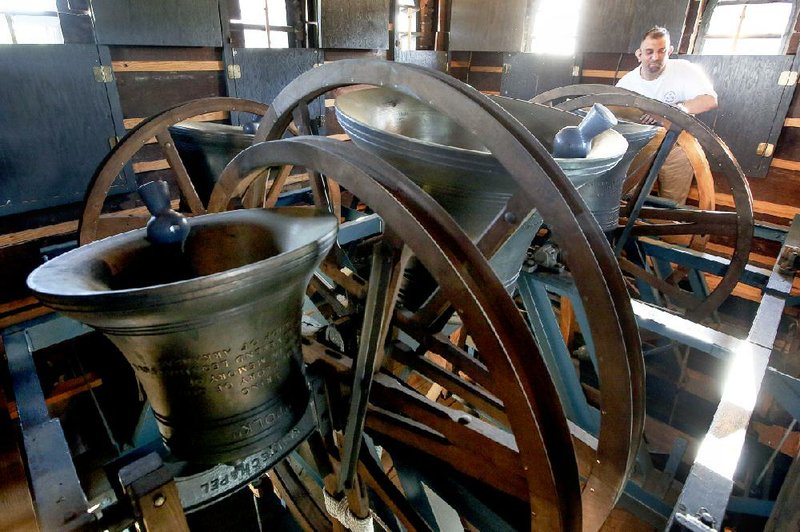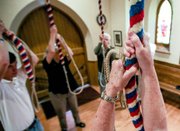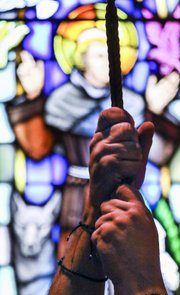When the change ringing bells of Trinity Episcopal Cathedral are rung, the sound resonates throughout the surrounding Little Rock neighborhood.
Depending on the order in which the bells are rung, they can toll for a funeral, announce the departure of a newlywed couple, or announce that a Sunday service is about to begin.
On Thursday, Trinity Episcopal Cathedral will begin hosting its annual Seven Towers Festival, a dayslong event during which bell ringers from the nearer seven towers that house change ringing bells will gather for classes, workshops and, most importantly, to ring the bells together.
Playing host to this year's festival carries an extra significance for the church. It marks the 30th anniversary of the casting and installation of Trinity's bells.
Change ringing bells are rung in a controlled manner, which varies the order in which they produce sound.
"We're not musical, we're methodical," said Mary Wilson, tower captain of the Trinity Episcopal Bell Ringing Society.
Instead of ringing tunes, members ring methods in which a set of memorized patterns are carried out when given the word to start. There are also call changes, in which members are instructed by a conductor to actively make changes to the sequences they are ringing, and in turn vary the order of tones sounded.
Trinity is one of two churches in Arkansas with change ringing bells; the other is First Presbyterian Church in Texarkana. Three of the other five churches taking part in the event are from Houston, with the other two from Shreveport and Dallas.
One of the distinctions of change ringing is that the bells rest mouth-side up by default.
"Consider it like a gun. It's armed and ready to go," said William Hronas, of the way the bells are hung.
Hronas, a member of the society, first began ringing at Trinity in 1998. The bells ring in the key of A, Hronas said, but each bell has its own pitch.
Each bell is mounted onto a cast iron member called a headstock. It's the wooden, grooved wheel onto which the headstock is mounted and allows bell ringers, with the aid of several pulleys, to time and coordinate the rings.
Members pull on a rope threaded around the wheel and through a hole in the floor to a ringing room below, where they stand in a circle to ring. Each rope has a tufted woolen section called a sally and a looped end -- referred to as the tail -- that allow one person, with the aid of a pulley above the ringing room's ceiling, to control the rings of a single bell that can weigh up to 1,000 pounds.
"What sets change ringing apart from towers around the world and makes them [different from conventional bells], it's on this wheel," said Philip Buck, who began ringing at Trinity more than 25 years ago, when he was 13. "It makes all the difference."
Buck said each rope is like a spool of thread, which wraps around the wheel to rotate the bell 360 degrees one way, then 360 degrees the other way, with roughly two seconds between rings.
Louvered windows surrounding the bells at Trinity are opened to allow the sound to escape, although they are kept closed "out of respect to the neighborhood" when practicing on Wednesdays, Wilson said.
Rather than producing sound while obeying gravity and swinging back and forth as with traditional bells, the clapper of a change ringing bell works with gravity. It uses momentum set in motion by a bell ringer's pull of the rope and swinging up to strike the bell three-quarters of a second after it has completed its 360-degree turn and come to a brief rest on the other side, meaning a bell ringer must time his motions carefully. Because of these distinctions, the bells are rung systematically.
The church's eight bells range in size and weight, beginning with the treble bell, which weighs 338 pounds, to the tenor bell, which weighs 1,009 pounds. All eight bells are named for someone integral to the history of Trinity, the bells or their installation at the church's centennial in 1987.
The eight bells were cast at Whitechapel Bell Foundry, which is also known for casting the Liberty Bell in Philadelphia and the bell that hangs in the Palace of Westminster's Elizabeth Tower known as Big Ben. Founded in 1570 during the reign of Queen Elizabeth I, the foundry will close its doors for good on Monday, but until then remains the oldest company in London.
Change ringing dates to the 1600s in England, where it was first a "gentleman's activity of leisure," according to Hronas, and only later became a family activity.
Currently there are 47 churches with change ringing bells in the United States. The society is an active member of the North American Guild of Change Ringers, which holds annual conferences. Society members have rung bells in towers from Edinburgh, Scotland, to London and New Zealand.
"Once you ring here, it's a ticket to ring around the world," Buck said.
Porter Brownlee, an engineer and a bell ringer at the church, was involved with the original construction of the concrete tower housed within the original 1880s tower, where it was always hoped bells would someday hang. He recalled his beginning as a bell ringer after the church's choirmaster at the time, Charlie Rigsby, all but ushered him into ringing.
"He more or less said, 'When are you going to take a lesson?' and I said, 'Maybe sometime I'll take a lesson.' He said, 'How about next Tuesday at 5?'" said Brownlee, who has been ringing ever since.
The youngest current bell ringer, Adam Whitfield, is 18 and a senior at Little Rock Central High School. Whitfield followed tradition in becoming a bell ringer after his father, Scott Whitfield, the choir director at Little Rock Central, began ringing.
For some bell ringers, the pure sound of the bells was a draw.
Hronas, who grew up down the street from the church, said he developed an interest after having the chance to "chime" a bell as a child, and from hearing the bells on Sundays when leaving with his parents to attend Annunciation Greek Orthodox Church, where he is still a member.
Dick Dearnley, an investment adviser, became involved when he and his wife, Maggie, moved to Little Rock in the early 1990s and heard the bells. After taking her husband to some practices, Maggie Dearnley also became a bell ringer and the two have been ringing together ever since.
"We're an eclectic group," Wilson said. "Different personalities, different ages, different everything."
"We like each other. We were friends before we became ringers," Brownlee said. "I think it's very, very pleasant that the group of us places our friendships first. The ringing is something we do for enjoyment, but we're not going to jeopardize the relationships that we have."
"We also ring for the church, and a lot of towers don't," Wilson added. "They just ring to ring, and we ring for the church. It's a call to worship. We go to church here, this is our church home, and we ring for the church."
The society will hold a dinner May 6, the last evening of the festival, during which it will present miniature replicas of the church's eight bells to the descendants and families of those after whom the bells were named. A few of the namesakes are still alive and will be present, such as Joel Pugh, a former dean of the church.
Leonidas Polk, the Confederate general and Arkansas' first bishop after whom the treble bell is named, will be represented by seven of his descendants at the dinner, Brownlee said.
In the meantime, the nine members of the society are training five new ringers, all of whom began their foray into change ringing around the same time last fall.
Jane Thompson, one of the bell ringers in training, said change ringing is among the hardest things she has ever done.
"But the irony is that little kids can do this really well," she said. "The younger you are, the easier it is."
New members are always welcome -- the society retains about 25 percent of those who come to ring, Brownlee noted -- and Buck encourages anyone interested in bell ringing to contact Wilson or Brownlee at the church.
Having a sense of rhythm isn't necessary to become a bell ringer. In fact, Buck said, those with a background in music may be hindered when first trying to ring.
"Being able to read sheet music or being able to do higher math is not a prerequisite," he said.
Once mastered, however, the sound will seamlessly blend into services, weddings or other special occasions.
"When we know we're ringing well is when people don't notice it," Buck said. "It's only when you're playing and people look up [that] you're not ringing well."
Religion on 04/29/2017


